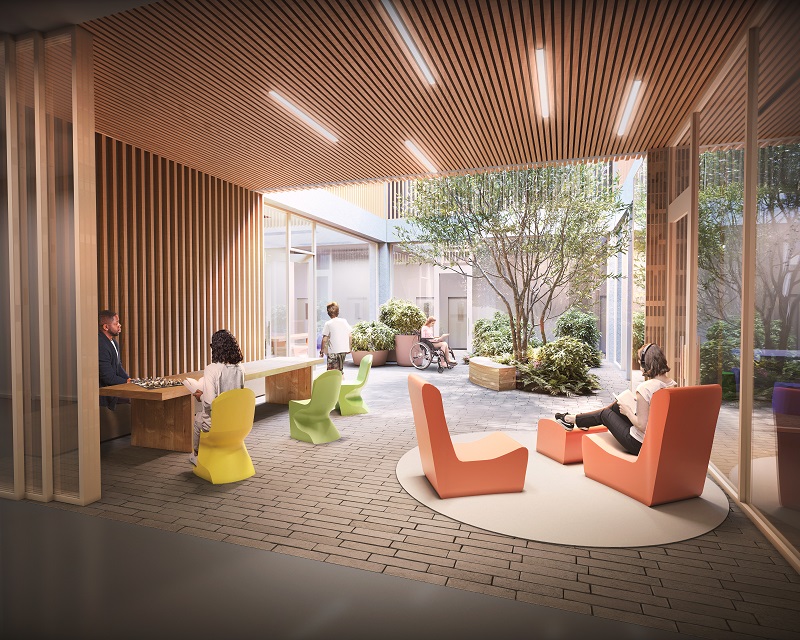Designs show patient-centred, low-carbon facility which combines physical and mental health services alongside world-renowed research

Early designs have been unveiled as part of a fresh planning application for the proposed new Cambridge Children’s Hospital development.
The submission of the formal ‘reserved matters’ planning application for the new facility builds on the existing outline planning permission, which was granted for the site previously.
The new hospital will have an estimated total footprint of around 36,000sq m , including 5000sq m of research space.
And the drawings give an early indication of how the innovative hospital might look when it opens in 2025.
The project’s holistic approach focusing on the whole child is ground-breaking and will inspire many generations of new hospitals
To be built on the Cambridge Biomedical Campus, the hospital will be the region’s first dedicated children’s hospital.
Embedding genomic and psychological research alongside clinical expertise in physical and mental child health, it will focus on taking care of the whole child, not just their illness.
International impact
And it will pass on that knowledge to international hospitals and institutions, sharing ground-breaking research with the aim of benefiting as many young people as possible.
Andrew Tollick, senior programme manager for design and construction at the hospital, said: “This is a big milestone for Cambridge Children’s Hospital, not only in planning terms, but in sharing our vision for ‘a whole new way’ of delivering services; one that integrates children’s mental and physical health alongside world-class research to provide holistic, personalised care in a state-of-the-art facility.”
An international design team has been put together to deliver the project, comprised of experts from Turner & Townsend, Hawkins\Brown, White Arkitekter, Ramboll, and MJ Medical, with support from planning consultant, Bidwells; and fire consultancy, Alfor.
And staff, patients, young people, parents and carers from across the region, have also been instrumental in helping shape how the facility will look and feel in these early designs.
A low-carbon approach
The hospital’s form is designed to encourage play and bring in light.
Outdoor courtyards at all levels give children opportunities to interact, learn, empathise, and heal.
And distributing these spaces throughout the building brings natural light and air into the depth of the plan, creating visual connections across wards, while dramatically reducing the building’s operational lighting requirements.
The design of the whole building will be psychologically informed, founded in the knowledge that architecture contributes to healing and patient wellbeing
Designed to Passivhaus sustainability principals, and expected to achieve a BREAAM ‘Excellent’ sustainability rating as a minimum; the environmental impact of the new facility is central to the plans.
The hospital will include as many outdoors spaces as possible, including gardens, courtyards, and terraces to provide access to nature and spaces for play and relaxation that support biodiversity and wildlife.
And the main hospital building will itself be enclosed within a wide landscaped green perimeter that recreates the feel of a summer meadow.
Inspiring a new generation
Speaking to hdm, Cristiana Caira, healthcare design lead architect at White Arkitekter, said: “The project’s holistic approach focusing on the whole child is ground-breaking and will hopefully inspire many generations of new hospitals.
“Redefining the boundaries between mental and physical health is already being discussed in the UK and Scandinavia, but this project turns the page in the history of hospital planning, integrating physical and mental health of children and young people alongside the world-leading research of Cambridge University.
“It has been incredibly interesting to be part of this journey and our amazing design team has worked closely with the staff, parents, and children to design a completely-new typology of hospital that addresses all needs and aspirations.
“The design of the whole building will be psychologically informed, founded in the knowledge that architecture contributes to healing and patient wellbeing.
“This will be a place to learn, play, heal and recover – indoors and out.”
A unique opportunity
Negar Mihanyar, associate director and education sector lead at Hawkins\Brown, adds: “The Cambridge Children’s Hospital project represents a unique opportunity to consider a whole new approach to healthcare for young people – focused on the mind as well as the body – with research embedded alongside the clinical facilities.
This project turns the page in the history of hospital planning, integrating physical and mental health of children and young people alongside the world-leading research of Cambridge University
“This nurturing environment will create a national and global exemplar for future healthcare in a brand-new hospital designed to take care of the whole child, not just their illness.
“The team is bringing together its expertise to create an integrated, forward-thinking healthcare model combining mental and physical care, alongside academic research, all within an innovative hospital building.
“We are excited to see this project progress and to bring this new kind of facility to children and young people in Cambridge as well as at the wider region.”
Building work is due to start in 2023 and is due for completion in 2025.